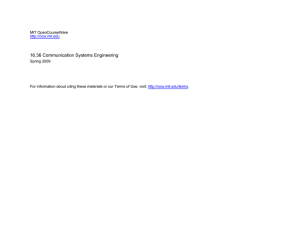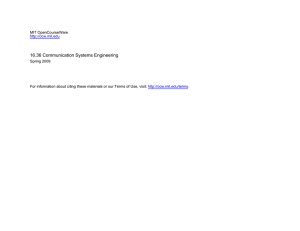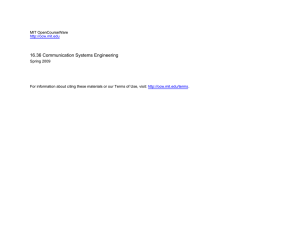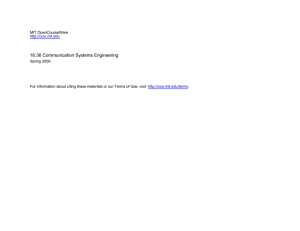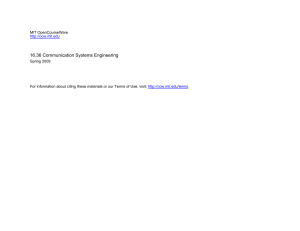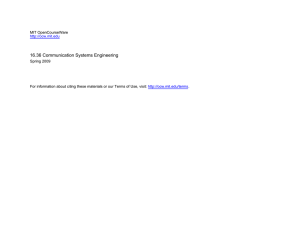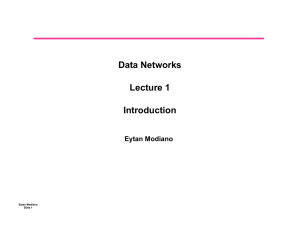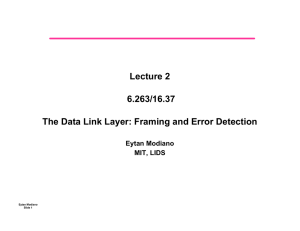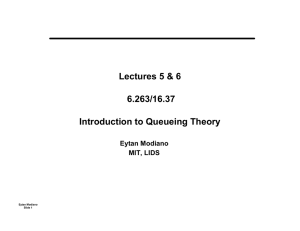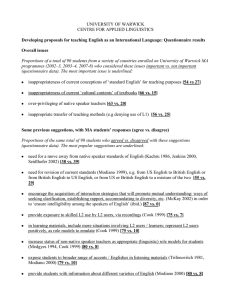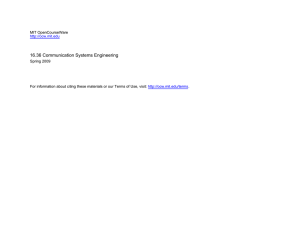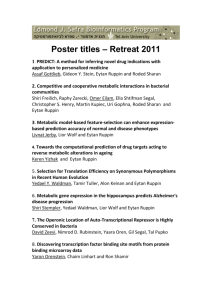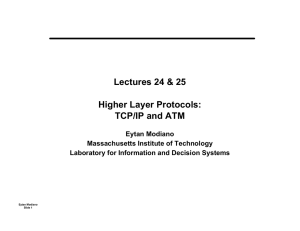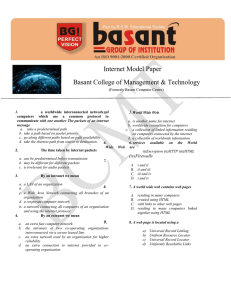16.36 Communication Systems Engineering
advertisement
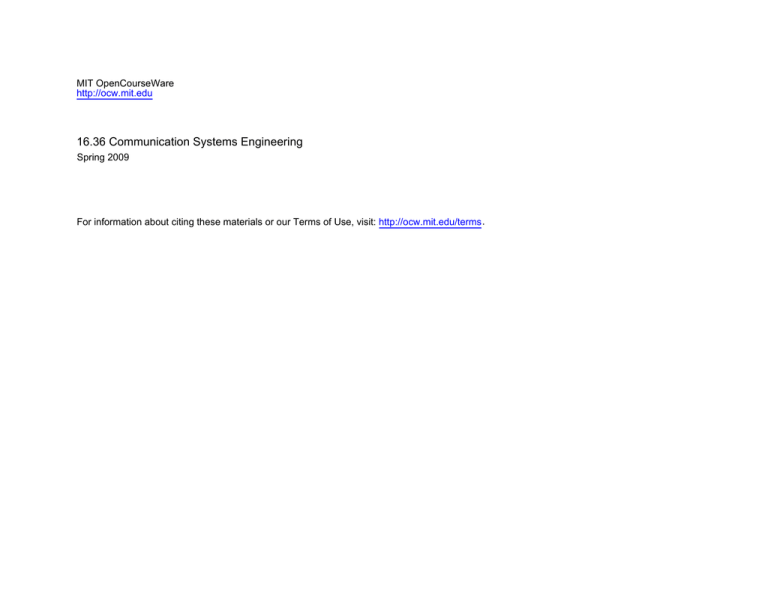
MIT OpenCourseWare http://ocw.mit.edu 16.36 Communication Systems Engineering Spring 2009 For information about citing these materials or our Terms of Use, visit: http://ocw.mit.edu/terms. 16.36: Communication Systems Engineering Lecture 1: Introduction February 3, 2009 Eytan Modiano Eytan Modiano Slide 1 Timeline of modern communication Analog Comm Systems Digital Comm Systems Networked Comm Systems (data packets) Eytan Modiano Slide 3 • • • 1876 - Bell Telephone 1920 - Radio Broadcast 1936 - TV Broadcast • • 1960’s - Digital communications 1965 - First commercial satellite • 1970 - First Internet node • • 1980 - Development of TCP/IP 1993 - Invention of Web ~ 2000 - Internet traffic surpasses voice! Typical Communication Classes • Old days (1980s): Teach analog and digital communications in separate classes – Networking was sometimes taught as a graduate class, but most people did not see much use to it! • Today: Most communication classes focus mainly on digital – Some classes may teach some analog for “historical” reasons – Networking classes are offered at both undergraduate and graduate levels • This class will introduce concepts of communications and networking at the undergraduate level – First attempt at combining concepts from both Importance of not thinking of the two systems as separate systems • Other offerings (advanced) – 16.37/6.263: Data Networks – 6.450: Digital Communications Eytan Modiano Slide 4 Why communications in AA? • AA Information Initiative ~ 1997 – – – Communications Software and computers Autonomous systems • Computers are a vital part of an Aerospace system – – – Control of system, Human interface Involves computers, software, communications, etc. E.g., complex communication networks within spacecraft or aircraft • Space communications is a critical industry – Satellite TV, Internet Access, NASA, DoD • Information technology is a critical engineering discipline – Eytan Modiano Slide 5 These skills are as fundamental today as the knowledge of basic math or physics Communication Applications • Broadcast TV/Radio – – • Digital telephony – • Recent move toward digital broadcast (Satellite TV/Radio) 2009: all TV broadcast is going digital (HDTV) - why? Wired and wireless Computer communications/networks – Resource sharing Computing: mainframe computer (old days) Printers, peripherals Information, DB access and update – Internet Services Email, FTP, Telnet, Web access • Today, the vast majority of network traffic is for internet applications – Internet is also starting to carry traditional applications Radio, TV, phone Eytan Modiano Slide 8 Types of Networks • Wide Area Networks (WANS) – Span large areas (countries, continents, world) – Use leased phone lines (expensive!) 1980’s: 10 Kbps, 2000’s: 2.5 Gbps User access rates: 56Kbps – 155 Mbps typical – Shared communication links: switches and routers E.g, IBM SNA, X.25 networks, Internet • Local Area Networks (LANS) – Span office or building – Single hop (shared channel) (cheap!) – User rates: 10 Mbps – 1 Gbps E.g., Ethernet, Token rings, Apple-talk Eytan Modiano Slide 9 Network services • • • • Synchronous (stream) – Session appears as a continuous stream of traffic (e.g, voice) – Usually requires fixed and limited delays Asynchronous (bursty) – Session appears as a sequence of messages – Typically bursty – E.g., Interactive sessions, file transfers, email Connection oriented services – Long sustained session – Orderly and timely delivery of packets – E.g., Telnet, FTP Connectionless services – • Eytan Modiano Slide 10 QoS One time transaction (e.g., email) Switching Techniques • Circuit Switching – – • Packet Switching – – Eytan Modiano Slide 11 Dedicated resources Traditional telephone networks Shared resources Modern data networks Circuit Switching • Each session is allocated a fixed fraction of the capacity on each link along its path – Dedicated resources – Fixed path – If capacity is used, calls are blocked E.g., telephone network • Advantages of circuit switching – Fixed delays – Guaranteed continuous delivery • Disadvantages – Circuits are not used when session is idle – Inefficient for bursty traffic – Circuit switching usually done using a fixed rate stream (e.g., 64 Kbps) Difficult to support variable data rates Eytan Modiano Slide 12 Packet Switched Networks Messages broken into Packets that are routed To their destination PS PS PS Packet Network PS PS PS Buffer PS Eytan Modiano Slide 13 Packet Switch 7 Layer OSI Reference Model Application Application Virtual network service Presentation Presentation Virtual session Session Session Virtual link for end to end messages Transport Transport Virtual link for end to end packets Network Network Network Network Virtual link for reliable packets Data link Control DLC DLC DLC DLC phys. int. phys. int. Data link Control Virtual bit pipe physical interface phys. int. phys. int. physical interface Physical link Eytan Modiano Slide 14 External Site subnet node subnet node External site Layers • Presentation layer – Provides character code conversion, data encryption, data compression, etc. • Session layer – Obtains virtual end to end message service from transport layer – Provides directory assistance, access rights, billing functions, etc. • Standardization has not proceeded well here, since transport to application are all in the operating system and don't really need standard interfaces • Focus: Transport layer and lower Eytan Modiano Slide 15 Transport Layer • The transport layer is responsible for reliable end-to-end transmission of messages across the network – The network layer provides a virtual end to end packet pipe to the transport layer. – The transport layer provides a virtual end to end message service to the higher layers. • The functions of the transport layer are: 1) Break messages into packets and reassemble packets of size suitable to network layer 2) Multiplex sessions with same source/destination nodes 3) Resequence packets at destination 4) recover from residual errors and failures 5) Provide end-to-end flow control Eytan Modiano Slide 16 Network layer • The network layer is responsible for routing of packets across the network – The network layer module accepts incoming packets from the transport layer and transit packets from the DLC layer – It routes each packet to the proper outgoing DLC or (at the destination) to the transport layer – Typically, the network layer adds its own header to the packets received from the transport layer. This header provides the information needed for routing (e.g., destination address) Each node contains one network Layer module plus one Link layer module per link Transport layer Network layer Eytan Modiano Slide 17 DLC layer link 1 DLC layer link 2 DLC layer link 3 Link Layer • Responsible for error-free transmission of packets across a single link – Framing Determine the start and end of packets – Error detection Determine which packets contain transmission errors – Error correction Retransmission schemes (Automatic Repeat Request (ARQ)) Eytan Modiano Slide 18 Internetworking with TCP/IP FTP client FTP Protocol TCP TCP Protocol FTP server TCP ROUTER IP IP Protocol IP Protocol IP IP Ethernet driver Ethernet Protocol Ethernet Eytan Modiano Slide 19 Ethernet driver token ring driver token ring Protocol token ring token ring driver Physical Layer • Responsible for transmission of bits over a link • Propagation delays – Time it takes the signal to travel from the source to the destination Signal travel approximately at the speed of light, C = 3x108 meters/second – E.g., LEO satellite: d = 1000 km => 3.3 ms prop. delay GEO satellite: d = 40,000 km => 1/8 sec prop. delay Ethernet cable: d = 1 km => 3 µs prop. delay • Transmission errors – – – Signals experience power loss due to attenuation Transmission is impaired by noise Simple channel model: Binary Symmetric Channel P = bit error probability Independent from bit to bit – Eytan Modiano Slide 20 In reality channel errors are often bursty 1-P 0 P 1 0 P 1-P 1 Basic elements of the physical layer Input from Higher layer Channel encoder modulator Channel Output to higher layer • • Channel decoder Demodulator In the traditional view of communication system the input was an analog information source (typically voice) In order to digitally transmit analog information one needs to convert this analog waveform into a digital waveform – Sampling, Quantization, Source coding • In modern computer networks the information source is often digital to begin with – Analog to digital conversion is not viewed as a part of the communication system, but as a higher layer function (application) Eytan Modiano Slide 21 Transmission of Information • Information source – – • Signal – – • Can remove unwanted “noise” to reproduce digital signal Can eliminate redundancy Digital transmission of continuous data – – – Eytan Modiano Slide 22 Analog (continuous valued) Digital (discrete valued) Why digital transmission? – – • Continuous - e.g., voice, video Discrete - e.g., text, computer data Sample Quantize Encode Elements of a digital communication system • Source coding – Used to compress the data Lossy, lossless • Channel coding – – • Used to overcome unwanted channel noise Introduce “redundancy” to protect against errors Modulation – Represent bits using continuous valued signals suited for transmission Impose discrete valued signals on an analog waveform Typically use sine or cosine wave Eytan Modiano Slide 23 Transmission channels • Electro-magnetic transmission – – • Optical Transmission – • Media: optical fiber, free space (satellite) Storage – – Eytan Modiano Slide 24 Guided medium: twisted pair, coaxial cable Unguided medium (air): radio transmission, satellite Magnetic (tape, disk) Optical (CD) Frequency spectrum • Transmission over the airwaves uses different frequency bands • Useful frequency bands are not limitless • Spectrum is a natural resource that must be used efficiently • Spectrum is allocated to operators by the Government – Eytan Modiano Slide 25 Federal Communications Commission (FCC) Frequency spectrum Use Ultraviolet Visible light 10-6 m 1015Hz Experimental Infrared Millimeter waves 1cm Super high frequency (SHF) 10 cm Ultra high frequency (UHF) Wavelength 1m Very high frequency (VHF) 10 m High frequency (HF) 100 m 1014Hz 100 GHz Experimental Navigation Satellite to satellite Microwave relay Earth-satellite Radar 1 GHz UHF TV Mobile, aeronautical VHF TV and FM broadcast Mobile radio Business Amateur radio International radio Citizen's band Medium frequency (MF) AM broadcast Low frequency (LF) Aeronautical Navigation Radio teletype Shortwave radio 100 MHz 10 MHz 1 MHz 1 km 10 km Microwave radio 10 GHz Frequency Frequency band 100 kHz Very low frequency (VLF) 10 kHz Audio band 1 kHz Longwave radio 100 km Eytan Modiano Slide 26 Frequency range for wireless electromagnetic channels. Figure by MIT OpenCourseWare.
